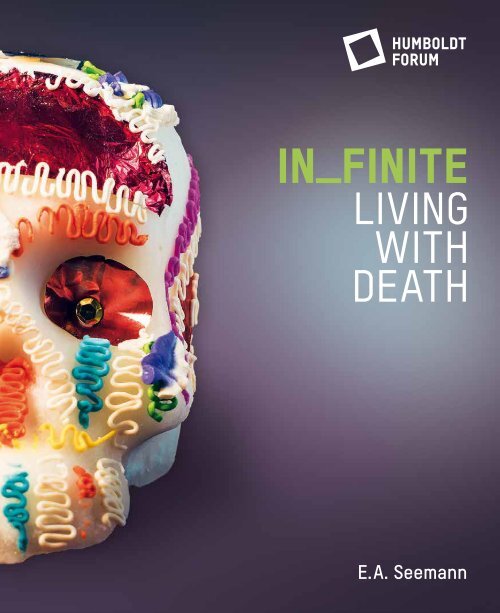Create successful ePaper yourself
Turn your PDF publications into a flip-book with our unique Google optimized e-Paper software.
<strong>IN</strong>_F<strong>IN</strong>ITE<br />
LIV<strong>IN</strong>G<br />
WITH<br />
DEATH
<strong>IN</strong>_F<strong>IN</strong>ITE<br />
LIV<strong>IN</strong>G<br />
WITH<br />
DEATH<br />
If we tell the story of the universe <strong>with</strong>in a timespan of<br />
twenty-four hours, Homo sapiens appears only in the final<br />
second. According to scientific calculations, the universe<br />
is 13.8 billion years old. The first traces of life in the form of<br />
bacteria-like single-celled organisms date back approximately<br />
3.8 billion years. Homo sapiens has been verifiably<br />
living on Earth for some 300,000 years.<br />
pp. 2–3<br />
Star cluster Westerlund 2<br />
(image taken <strong>with</strong> the Hubble Space Telescope)<br />
The star cluster is located in the Milky Way and is<br />
approximately 20,000 light years away from Earth.<br />
Its estimated age is one to two million years.<br />
pp. 4–5<br />
Cirrus Nebula<br />
(image taken <strong>with</strong> the Hubble Space Telescope)<br />
The Veil Nebula is approximately 2,100 light years away from<br />
Earth and is one of the best-known remnants of a supernova.<br />
This occurred when a star exploded some 8,000 years ago.<br />
pp. 6–7<br />
The centre of the Milky Way glowing in dust<br />
(image taken <strong>with</strong> the Spitzer Space Telescope)<br />
The Milky Way is our home galaxy, <strong>with</strong>in which the solar<br />
system containing Earth is located. It consists of hundreds of<br />
billions of stars and is approximately 13.6 billion years old.<br />
pp. 8–9<br />
Earthrise<br />
Earth, the place of origin and home of all living creatures<br />
known to date, was formed approximately 4.6 billion years<br />
ago. The photograph was taken from the Apollo 8 spacecraft<br />
in 1968.
CONTENTS<br />
14 Foreword<br />
Hartmut Dorgerloh<br />
16 Introduction<br />
Detlef Vögeli<br />
THE HEREAFTER<br />
22 IS THERE LIFE AFTER DEATH?<br />
24 Four Ways to Live for Ever<br />
Stephen Cave<br />
29 Contemporary Notions of the Hereafter<br />
Félix Ayoh’Omidire / Esther Hirsch / Kadir Sanci /<br />
Jasmin El-Manhy / Vilwanathan Krishnamurthy / Thien My /<br />
Ringu Tulku Rinpoche / Bhai Kashmir Singh / Pir Hasan Doğan /<br />
Mario Vázquez / Mark Benecke / Emil Kendziorra<br />
54 Dead and Alive<br />
Klaus Bo<br />
DY<strong>IN</strong>G<br />
70 WHAT IS A GOOD DEATH?<br />
72 <strong>Death</strong> and Dying in Non-Western Cultures<br />
Helaine Selin and Robert M. Rakoff<br />
75 World <strong>Death</strong> Conference<br />
Rafael Ernesto Mamanché González / Noreen Chan /<br />
Kodjo Senah / Aysel Erki / Anurag Hari Shukla / Myriam Rios /<br />
Mike Kelly / Hadley Vlahos / Bukelwa Sigila / Rachel Ettun /<br />
Patrice Dwyer / Thích Thiện Nguyện<br />
DEATH<br />
100 WHAT HAPPENS AT THE F<strong>IN</strong>AL MOMENT?<br />
102 “The last wave of elec trical discharge before death is<br />
an enormous event”<br />
Interview <strong>with</strong> Jens Dreier<br />
THE MORTUARY<br />
110 WHAT DOES HUMAN DIGNITY MEAN BEYOND DEATH?<br />
112 <strong>Living</strong> <strong>with</strong> the Dead. <strong>Living</strong> <strong>with</strong> <strong>Death</strong><br />
Liv Nilsson Stutz<br />
118 Care for the Dead<br />
123 Autopsy of the Conditions of <strong>Death</strong> across the Globe<br />
136 The Names behind the Numbers<br />
148 “It’s inhumane to let people die this way”<br />
Interview <strong>with</strong> Cristina Cattaneo<br />
GRIEF<br />
152 HOW DO WE F<strong>IN</strong>D SOLACE?<br />
154 “Grief is a messy, painful affair”<br />
Interview <strong>with</strong> Julia Samuel<br />
OPEN END<br />
160 WHAT WILL REMA<strong>IN</strong>?<br />
162 On the End of Evolution<br />
Matthias Glaubrecht<br />
168 Cabinet of Extinct and Endangered Species<br />
180 The Democracy of Species<br />
Robin Wall Kimmerer<br />
184 “The distinction between human history and natural<br />
history is no longer tenable”<br />
Interview <strong>with</strong> Dipesh Chakrabarty<br />
188 Credits
<strong>IN</strong>TRODUCTION<br />
LIV<strong>IN</strong>G WITH DEATH.<br />
A HUMAN DRAMA<br />
Detlef Vögeli<br />
“This is the paradox: he [man] is out of nature<br />
and hopelessly in it; he is dual, up in the stars and yet<br />
housed in a heart-pumping, breath-gasping body that<br />
once belonged to a fish and still carries the gill-marks to<br />
prove it. His body is a material fleshy casing that is alien<br />
to him in many ways – the strangest and most repugnant<br />
way being that it aches and bleeds and will decay<br />
and die.” 1<br />
Ernest Becker, The Denial of <strong>Death</strong><br />
Homo sapiens is probably the only animal that knows it<br />
will die. Only humans are aware of their own existence –<br />
and therefore also of their vulnerability and transience.<br />
We know that our life is finite; and at the same time, like<br />
all living things, we have an instinctive drive to survive.<br />
We must live <strong>with</strong> death.<br />
The cultural anthropologist Ernest Becker argued that<br />
the fear of death determines all human behaviour. This<br />
fear and the longing for immortality are the main driving<br />
forces of human activity. Both the noblest and the most<br />
repulsive forms of human endeavour stem from the<br />
awareness that we are mortal. The knowledge of death<br />
has shaped the course of human history, giving rise to<br />
culture, civilization, science and world views. Humans<br />
have woven stories and rituals to make the inexplicable<br />
comprehensible, the unbearable bearable, and to give<br />
meaning to our finite lives.<br />
The scientific-biological understanding of physical<br />
death as the end of human existence that prevails in<br />
enlightened, secularized societies is more recent.<br />
According to his standard work on the history of death<br />
published by French historian Philippe Ariès in 1977,<br />
death had been “expatriated” from modern Western society<br />
in the course of the 20th century: “Until the age of<br />
scientific progress, human beings accepted the idea of<br />
a continued existence after death.” 2 <strong>Death</strong>, he states, is<br />
integrated into the cultural narratives of society, a part of<br />
the social world of meaning. Ariès describes pre-modern<br />
death as “tame” and modern death as “wild”. 3<br />
Despite all scientific progress, death remains a phenomenon<br />
that is beyond our understanding. We know<br />
less about the moment after death than about anything<br />
else. <strong>Death</strong> is perhaps the last inaccessible frontier of<br />
knowledge-based society.<br />
Talking about death requires allowing and enduring<br />
polyphony and ambiguity. To ponder one’s own death<br />
and finitude is to reflect on the human relationship to<br />
the world, a locating of our lives <strong>with</strong>in the community,<br />
<strong>with</strong>in society, <strong>with</strong>in the universe. When we talk about<br />
ideas of life <strong>with</strong> and after death, we are talking about<br />
world views – beyond right and wrong. The knowledge<br />
of the transience and fragility of human life and all living<br />
things confronts us <strong>with</strong> existential and ethical-moral<br />
questions.<br />
The contributions in this book are an invitation to approach<br />
the finiteness of life from various perspectives.<br />
They offer insights into different worlds of imagination<br />
and experience. Documentary contributions from the exhibition<br />
in_finite. <strong>Living</strong> <strong>with</strong> <strong>Death</strong> are complemented by<br />
introductory essays and photo spreads. The focus is on<br />
the question of our personal and social relationship <strong>with</strong><br />
finite nature. The publication spans an arc from individual<br />
death to the impending extermination of the species<br />
Homo sapiens as a result of the sixth mass extinction.<br />
Historical and cultural evidence suggests that humans<br />
have always done everything possible to postpone<br />
or overcome death – both factually and symbolically<br />
( Stephen Cave, p. 24).<br />
In many cultures, death was and is understood as a<br />
change of state, a transition into another form of existence.<br />
The promise of a life in the hereafter provides<br />
meaning and orientation – be it the idea of a paradise<br />
in Islam or Christianity, a moks· a in Hinduism, nirvana in<br />
Buddhism, or an ancestral world in the Yoruba religion.<br />
The aim is to lead a good life according to certain rules,<br />
to follow one’s personal dharma, to live in a God-conscious<br />
way. <strong>Death</strong> embeds the individual <strong>with</strong>in a larger narrative,<br />
<strong>with</strong>in a cosmology that provides a framework for<br />
behaviour and promises existence in a better world as a<br />
reward (Contemporary Notions of the Hereafter, p. 29).<br />
Dying and death are universal facts; the way we deal <strong>with</strong><br />
them is culturally and individually shaped (Helaine Selin,<br />
Robert M. Rakoff, p. 72). What counts in the last days,<br />
hours and minutes before death? What do people regret<br />
on their deathbed? What comforts them? How universal<br />
is the process of dying? What role do cultural and reli gious<br />
beliefs play at the end of life? Twelve individuals who<br />
accompany others to death at the end of their lives talk<br />
about their experiences and rituals (World <strong>Death</strong> Conference,<br />
p. 75).<br />
The neurologist and stroke researcher Jens Dreier<br />
has observed what happens in the brain during the final<br />
phase of dying. He speaks of the final wave of release<br />
before death. What happens after death at the level of<br />
consciousness remains a mystery: “Everything that is<br />
accessible to us happens while the patient is still alive.<br />
What might happen afterwards is not accessible to science”<br />
(Jens Dreier, p. 102).<br />
Rituals can provide comfort during the process of dying<br />
and beyond death. The bioarchaeologist Liv Nilsson<br />
Stutz examines how the universal crisis of death is dealt<br />
<strong>with</strong> in different cultures and the significance of the ritual<br />
care of the corpse. Behind the diversity of funeral rituals<br />
in different cultures lies a universal human need in the<br />
face of death. Beneath the surface, she explains, “we<br />
also discover that our vulnerability is the same, and the<br />
need to make sense of the world and what is happening<br />
to us is a shared human condition. It is in these moments<br />
that we can see ourselves in the other, and the other in<br />
ourselves. It is encounters like this that we can begin to<br />
grasp our shared humanity and the responsibility that<br />
that entails” (Liv Nilsson Stutz, p. 112).<br />
<strong>Death</strong> unites us – and death divides us. Although no<br />
one is privileged enough to escape physical death, we<br />
are not all equal in the face of death. Social and geographical<br />
origins determine statistical life chances.<br />
<strong>Living</strong> conditions are also reflected in the conditions of<br />
death. Hygiene, affluence and medical care, as well as<br />
social and political conditions, determine how directly<br />
we are at the mercy of death. We are all living longer than<br />
ever before. However, the gain in lifespan is unequally<br />
distributed. People born in Nigeria, for example, have<br />
a life expectancy of less than fifty-three years, while in<br />
Germany it is currently over eighty years. People in the<br />
poorer regions of the world are already, and will continue<br />
to be, the main victims of climate change (Infographics,<br />
p. 123).<br />
We count the dead and investigate the causes of<br />
death in order to better protect human life in the future.<br />
According to international humanitarian law, the dead<br />
must be identified and buried. The forensic anthropologist<br />
Cristina Cattaneo has been working since 2013 to<br />
identify the nameless people who drowned in the Mediterranean<br />
Sea while attempting to flee to Europe. Identifying<br />
the dead is a question of human dignity – but it<br />
is also important for the bereaved so that they can have<br />
certainty and say goodbye (Cristina Cattaneo, p. 148).<br />
In psychology, “ambiguous loss” is the phenomenon of<br />
losing a loved one <strong>with</strong>out knowing whether or not they<br />
are still alive. This uncertainty delays the grieving process<br />
and can lead to unresolved grief. “Grief is the most<br />
intense emotional pain we know,” explains the psychotherapist<br />
Julia Samuel. She has been accompanying<br />
people in grief for more than three decades. In an interview,<br />
she explains how we can live <strong>with</strong> this pain – and<br />
why we should once again give death and mourning more<br />
space in our society (Julia Samuel, p. 154).<br />
However, death does not fit into an enlightened, rational<br />
world – not into the idea of the mastery of nature,<br />
according to which there are no natural limits that cannot<br />
be overcome at some point by science and technology.<br />
The successful development of Homo sapiens is also a<br />
history of this idea. The discovery of fire gave humans<br />
more energy than their muscles could provide. Today,<br />
16 <strong>IN</strong>TRODUCTION DETLEF VÖGELI 17
we burn as much oil, natural gas and coal worldwide in<br />
a single day as was created over the course of 500,000<br />
years. 4 These fossil fuels are the drivers of economic<br />
growth and prosperity – a finite resource, the product<br />
of plants and animals that died millions of years ago.<br />
Humans are moving both <strong>with</strong>in and beyond their natural<br />
limits. They use three-quarters of the Earth’s surface<br />
and two-thirds of its oceans and have thus become a<br />
planetary force that is upsetting the balance of natural<br />
processes that are billions of years old. An estimated<br />
one million species are threatened <strong>with</strong> extinction. The<br />
decline of biodiversity also threatens the very basis of<br />
human life (Matthias Glaubrecht, p. 162). We have become<br />
our own gravediggers.<br />
Are we thus at the beginning of the end of human<br />
history? The Indian historian Dipesh Chakrabarty is “not<br />
optimistic, but hopeful” – because human beings are<br />
capable of learning. He suggests broadening the global<br />
perspective on the world to include a planetary view that<br />
decentres humanity and understands its history as part<br />
of natural history (Dipesh Chakrabarty, p. 184).<br />
The stories we tell about ourselves and our relationship<br />
to the world are among the most powerful tools we<br />
have as humans. Robin Wall Kimmerer, a plant ecologist<br />
and member of the Potawatomi people, calls for combining<br />
Indigenous wisdom <strong>with</strong> science to reform our<br />
relationship <strong>with</strong> nature. She wants to bring ancient stories<br />
to life, stories in which humans do not stand at the<br />
top of a hierarchy as the purported crown of creation,<br />
but rather exist in a symbiotic interdependence <strong>with</strong> all<br />
living things; as part of the biosphere, dependent also on<br />
the flourishing of the non-human living world (Robin Wall<br />
Kimmerer, p. 180).<br />
How can we live <strong>with</strong> the awareness of our natural<br />
transience and the vulnerability of all living things? How<br />
can we live better <strong>with</strong> the responsibility that comes<br />
<strong>with</strong> this knowledge? What cultural narrative helps us to<br />
channel our fear of death in constructive ways? Or, in the<br />
words of Ernest Becker: “What is life-enhancing illusion?”<br />
5 – for us personally, as a community, as a society,<br />
as a species, and for the planet?<br />
This book, like the exhibition, is rich in experiential<br />
knowledge. Many thanks are due to the people from<br />
Berlin’s urban society who shared their ideas about death<br />
and a piece of their lives <strong>with</strong> us, as well as to the palliative<br />
care providers from around the world for sharing<br />
their touching and enriching encounters, for giving us<br />
insight into their experiences of caring for the dying<br />
and thus a “glimpse of human nature” (Noreen Chan,<br />
p. 78). These conversations and encounters would not<br />
have been possible <strong>with</strong>out the support of numerous<br />
medi ators, translators and interviewers from around the<br />
world. My express thanks go to all the authors for their<br />
contributions and expertise.<br />
My special thanks go to the curatorial team, my “Circle of<br />
Trust”, Gesine Last and Jan Zappe, as versatile contributors<br />
and active thinkers for their invaluable support on<br />
various levels, Kathrin Haase for her support in researching<br />
the protagonists for the World <strong>Death</strong> Conference, and<br />
Yvonne Zindel for researching the diverse protagonists<br />
from Berlin’s urban society <strong>with</strong> their different conceptions<br />
of the hereafter.<br />
Last but not least, my thanks are due to the Humboldt<br />
Forum Foundation: General Director Hartmut Dorgerloh for<br />
his great trust, the exhibition team led by Anke Daemgen,<br />
David Blankenstein and Frank Meißner, as well as Sibylle<br />
Kussmaul and Marc Wrasse from the Education and<br />
Outreach Department for their support, Susanne Müller-<br />
Wolff as the person responsible for the publication for<br />
her careful planning, and Barbara Martinkat for her stylish<br />
image editing.<br />
Thanks also go to Sahar Aharoni, whose skilful design<br />
has made this book look so inviting, to Barbara Delius for<br />
decisively enhancing the publication <strong>with</strong> her critical and<br />
constructive view of the big picture and her unerring eye<br />
for detail, and to Danko Szabó for his copy editing.<br />
1 Ernest Becker, The Denial of <strong>Death</strong>, London 1973, p. 26.<br />
2 Philippe Ariès, Philippe Ariès, The Hour of Our <strong>Death</strong> [1977], trans. Helen<br />
Weaver, New York 1981, p. 95.<br />
3 Ibid., p. 610.<br />
4 Jürgen Renn, “Das Anthropozän und die Geschichte des Wissens”, 28 February<br />
2022; ww.br.de/mediathek/video/prof-dr-juergen-renn-das-anthropozaen-und-die-geschichte-des-wissens-av:5dce82a1ebea9c001ad6f8bd<br />
[accessed on 30 January 2023].<br />
5 Becker 1973 (see note 1) p. 158 [emphasis in the original].<br />
18 <strong>IN</strong>TRODUCTION DETLEF VÖGELI 19
DEATH<br />
WHAT HAPPENS<br />
AT THE F<strong>IN</strong>AL<br />
MOMENT?<br />
What happens at the moment of death? Does the light at<br />
the end of the tunnel actually exist, and where does it come<br />
from? When is a person dead?<br />
<strong>Death</strong> is the final certainty in life. But when exactly a person<br />
is dead remains uncertain – the time of death cannot be<br />
clearly determined scientifically. What happens at the<br />
moment of (brain) death on the level of consciousness is<br />
a mystery. There are, however, insights into what happens<br />
in the brain during the last moments of life. Here, observations<br />
from neuroscience about the great wave that ushers<br />
in death and reports from people <strong>with</strong> a near-death experience<br />
are similar.
“THE LAST WAVE<br />
OF ELEC TRICAL<br />
DISCHARGE BEFORE<br />
DEATH IS AN ENOR-<br />
MOUS EVENT”<br />
Jens Dreier<br />
In an interview <strong>with</strong> Gesine Last und Detlef<br />
Vögeli, the experimental neurologist Jens Dreier<br />
talks about processes in the brain in the last<br />
minutes of life.<br />
You’re a neurologist and a professor at the<br />
Center for Stroke Research in Berlin. How did<br />
you become an expert in the physiological processes<br />
of dying?<br />
The Center has very many patients who have had<br />
strokes – which is an area I’ve been working on for many<br />
years. There are two main types of stroke. The ischaemic<br />
ones result from insufficient blood flow. And the haemorrhagic<br />
ones are a consequence of blood leaving the<br />
circulatory system and accumulating in the brain’s tissue<br />
or on its surface. I’m especially interested in this second<br />
type of stroke. Cerebral haemorrhages are caused, for<br />
example, by the rupture of an aneurysm. At the rupture,<br />
blood leaves the circulatory system and accumulates on<br />
the brain surface. This initial event is very dangerous<br />
for the patient. In addition to the damage that can occur<br />
immediately from the bleeding itself, there will often be<br />
subsequent strokes for about two weeks thereafter.<br />
These subsequent ones are ischaemic, and are known as<br />
delayed strokes. The mechanism underlying them is very<br />
complex, and that is my actual area of research. Delayed<br />
strokes worsen patient outcomes considerably. A major<br />
problem is that patients are often not conscious when a<br />
delayed stroke develops, which makes it extremely difficult<br />
to start treatment at the right time.<br />
What does that have to do <strong>with</strong> dying?<br />
The processes that occur during a stroke also occur in<br />
a similar form during dying. If someone suffers a stroke,<br />
nerve cells in a certain part of the brain die. If the whole<br />
person dies, all the nerve cells in their brain die. Our research<br />
includes animal studies as well as studies in patients<br />
in the intensive care unit (ICU), where we perform<br />
invasive neuromonitoring. For example, we continuously<br />
record the electrical brain activity. If certain changes in<br />
electrical voltage occur, they tell us that the patient is<br />
at risk of delayed stroke at that moment. Some of the<br />
patients we have monitored at Charité in Berlin or at our<br />
partner facility at the University of Cincinnati in Ohio<br />
have died during monitoring from complications of their<br />
severe underlying disease. We were thus able to record<br />
what happens in their brains when they die. The processes<br />
that take place during a stroke and during dying<br />
are closely related and can therefore be measured using<br />
the same methods.<br />
What processes do you mean?<br />
First of all, it is important to note that there are certain<br />
elements that always occur during dying, even if they do<br />
not always occur in the same order. The most striking<br />
feature of our recordings are enormous waves, the socalled<br />
“spreading depolarizations”, which I will describe<br />
in more detail in a moment. They occur during strokes<br />
and also during death. Although they are not the only<br />
mechanism, they are the most important in the transition<br />
from life to death.<br />
You said the sequence isn’t always the same.<br />
But does the process of dying still follow something<br />
like a script?<br />
Yes. There is always a phase in which the neurons are<br />
still alive but transitioning to a different functional state.<br />
And then there is the phase in which they actually die off,<br />
which takes a relatively long time. In ICU patients, the<br />
major differences are between death caused by cardiocirculatory<br />
arrest and death caused by death of the brain<br />
alone, although the rest of the body continues to live. The<br />
latter is often simply called “brain death” and refers to<br />
a condition in which the patient is ventilated and has an<br />
intact circulation and only the brain is no longer supplied<br />
<strong>with</strong> blood.<br />
Cerebral swelling is the reason for this. Because the<br />
brain doesn’t have much room to expand in the cranium,<br />
pressure rises in the brain. And when brain pressure exceeds<br />
systemic blood pressure, blood flow to the brain<br />
fails, which is incompatible <strong>with</strong> life for that individual<br />
although the rest of their body lives on in a biological<br />
sense. Both cardiovascular arrest and brain death are<br />
associated <strong>with</strong> spreading depolarizations but their patterns<br />
are quite different.<br />
What time frame are we talking about for the<br />
wave and for the death of neurons in the brain?<br />
When there is a sudden cardiac arrest and the heart<br />
stops beating completely, there may be a period when<br />
there is even some increase in brain activity. This ends<br />
after 30 or 40 seconds. Crucially, the activity ends by<br />
strongly inhibiting the neurons, but they remain alive and<br />
electrically charged. In this way, the cells save energy.<br />
However, they continue to consume a little energy until<br />
at some point they no longer have enough. Then the<br />
energy-dependent ion pumps in the cell membranes fail,<br />
and a tsunami of depolarization begins. Importantly, this<br />
tsunami is not death itself, but rather the wave triggers<br />
processes that lead to neuronal death <strong>with</strong> a significant<br />
time delay. In an adult <strong>with</strong> a normal body temperature,<br />
we would say that in a sudden cardiac arrest <strong>with</strong>out<br />
resuscitation, neurons begin to die about five to ten minutes<br />
after the circulatory arrest.<br />
Could we say it’s like a program that follows a<br />
certain logic?<br />
Yes, I think one could describe it as a type of program.<br />
A death that occurs naturally typically follows the cessation<br />
of cardiovascular and respiratory activity. If, for<br />
example, breathing stops first, the heart also stops working<br />
after a certain delay because it is no longer supplied<br />
<strong>with</strong> the oxygen necessary for pumping. All the organs,<br />
including the brain, will then no longer be supplied<br />
<strong>with</strong> blood. That is why resuscitation is so important. If<br />
someone pushes the chest down forcefully and rhythmically,<br />
restoring at least a little circulation that pumps a<br />
small amount of blood through the brain, it makes a big<br />
difference. Minimal blood supply to the brain through<br />
resuscitation delays neuronal cell death. The earlier resuscitation<br />
is started, the greater the likelihood that the<br />
person’s nerve cells will survive.<br />
How do the nerve cells respond when circulation<br />
stops?<br />
First of all, they briefly seem to show a changed rhythm.<br />
At this point, the nerve cells are not yet in a depressed<br />
state. Only after about 30 seconds are they then<br />
switched off. Although the inhibitory transmitters now<br />
dominate, tiny amounts of both excitatory and inhibitory<br />
transmitters continue to be released. An EEG (electroencephalogram)<br />
then shows a flatline, but this does not<br />
mean that nothing more happens during this phase. According<br />
to our measurements, another 13 to 266 seconds<br />
pass from the moment when no more brain activity can<br />
be detected to the point at which a spreading depolarization<br />
sets in, which implies an immense loss of electrochemical<br />
energy.<br />
A pivotal point.<br />
102 DEATH JENS DREIER 103
Absolutely. When the wave sets in, processes begin that<br />
are toxic for the nerve cells. The clock starts ticking. An<br />
enormous stress begins for the cells. For example, the<br />
nerve cells and their processes swell enormously, which<br />
you can observe under a two-photon microscope.<br />
What exactly happens when this wave is unleashed?<br />
This wave is truly a colossal event. Neurotransmitters are<br />
released en masse. There is actually no neurotransmitter<br />
that is not released during this phase. The wave spreads<br />
slowly throughout the brain. This releases a lot of electrochemical<br />
energy, which is converted into heat. At<br />
the front of the wave, there are a few action potentials,<br />
which are impulses that can also occur under normal<br />
conditions. Then there is utter silence. The simplest way<br />
to describe the wave is as a short circuit in a battery. The<br />
nerve cells lose their electrical charge <strong>with</strong> the wave.<br />
That means there’s no energy left to generate any more<br />
impulses. What I personally find important, however,<br />
is that this spreading depolarization is not the wave of<br />
death itself. That’s not the case. The wave induces toxic<br />
processes, after which it takes a while for the nerve cells<br />
as such no longer exists. In mechanistic terms, the occurrence<br />
of a vegetative state is connected <strong>with</strong> the fact<br />
that the cerebral cortex is considerably more susceptible<br />
than the brain stem to the development of a spreading<br />
depolarization.<br />
When does the process become irreversible?<br />
When the organelles of the depolarized nerve cells are<br />
so badly damaged that they can no longer function adequately<br />
even after energy is restored.<br />
So that’s the point of no return.<br />
Yes, but it is not simultaneous <strong>with</strong> the wave. The wave<br />
begins and you still have two or three minutes. Only then<br />
do the nerve cells begin to die. Energy is an apt image<br />
for me here. Our brains are normally full of energy. Each<br />
nerve cell is both a power plant that generates energy<br />
from oxygen and glucose, and an energy consumer.<br />
The energy produced in the power plants is stored and<br />
used to generate signal impulses. Normally, a very large<br />
amount of energy is stored, only a fraction of which<br />
is used in the form of impulses, or what are known as<br />
action potentials. But that’s still quite a bit. Although it<br />
a few minutes. If blood flow to the brain is not restored,<br />
all 86 billion of our neurons will eventually be completely<br />
discharged and eventually so poisoned that they will die.<br />
What does dying feel like? What do we know<br />
about it? You speak of an enormous wave.<br />
People also talk about a final great display of<br />
fireworks …<br />
The reports of patients who were resuscitated and<br />
survived are the only things we can rely on. A patient lies<br />
there, unconscious, and appears to be dead although<br />
that is not yet the case. Their heart no longer beats but<br />
their nerve cells are still alive. Around 15 percent of people<br />
who are resuscitated have a conscious experience<br />
during this period. There are various speculations about<br />
what might be responsible for near-death experiences.<br />
Such as?<br />
A relatively interesting thought is that there may be a<br />
surge of activity in the initial phase, a final flare-up, so to<br />
speak, before the spontaneous electrical activity of the<br />
brain comes to a halt. This surge of activity might have<br />
something to do <strong>with</strong> near-death experiences. What is<br />
migraine auras, however, also describe a type of tunnel<br />
vision and/or bright lights. The source of the aura is a<br />
wave, which is very similar to what occurs in a stroke or<br />
in the process of dying.<br />
Which phenomena are considered to be neardeath<br />
experiences?<br />
Notable features of near-death experiences include a<br />
sense of simultaneity, a sense of being in multiple places<br />
at essentially the same time, and the ability to be of different<br />
ages at the same time. That would fit in well <strong>with</strong><br />
a coordinated short-term process in the brain by which<br />
a great many nerve cells are – more or less simultaneously<br />
– activated and call up our (stored) memories at<br />
nearly the same time. A look back in time, when your life<br />
seems to flash before your eyes. Other phenomena include<br />
out-of-body experiences, although these can also<br />
be triggered in other contexts, such as during epileptic<br />
seizures or by magnetic stimulation of certain regions of<br />
the brain.<br />
To what extent are images like the white tunnel<br />
influenced by cultural and religious ideas?<br />
to die. If circulation and a supply of energy are restored<br />
after the onset of the wave, the process is entirely reversible<br />
up to a certain point in time and the nerve cells<br />
can also recover. In the case of a stroke, the waves can<br />
also spread far into healthy tissue <strong>with</strong> a normal blood<br />
supply, where they can have important signalling functions<br />
for the organism, so that their effects need not always<br />
be negative. It’s all very complicated.<br />
accounts for only 2 percent of the body’s weight, the<br />
brain uses 20 percent of our caloric intake to produce<br />
enough energy for its IT activities around the clock.<br />
In other words, as long as the body is at rest and not<br />
running a marathon, for example, the brain is the body’s<br />
greatest consumer of calories. That being said, much<br />
more energy is stored in the brain than is used at any<br />
given moment. Similar to a battery, energy is stored in<br />
also important is that different regions of the brain can<br />
be in various stages of the process of dying. One region<br />
might already show a spreading depolarization, whereas<br />
another might not yet be affected. Another possibility<br />
is that it is not actually the transitional phase from life<br />
to death that gives rise to near-death experiences but<br />
rather what happens afterwards if resuscitation is<br />
successful. What is also conceivable is that near-death<br />
Most studies on this topic tend to come from a Western<br />
cultural context. But I recently read a report from<br />
Sri Lanka, which has several religions in a relatively<br />
small geographic area. The researchers found different<br />
frequencies in the mention of near-death experiences,<br />
<strong>with</strong> a somewhat higher rate from areas <strong>with</strong> Christian<br />
influence. On the other hand, they reported such experiences<br />
from all the religions studied. Atheists, too, can<br />
Is there a point of no return?<br />
Yes, but this point is hard to define. For example, not all<br />
nerve cells die at the same time, because some are very<br />
vulnerable and others less so. That is why there can also<br />
be situations in which some nerve cells start dying but<br />
others are still alive. If resuscitation efforts are successful,<br />
the patient might lose some of their nerve cells<br />
and retain others. This, of course, is a crucial factor for<br />
the quality of life that can be achieved thereafter. One<br />
special variant here would be a vegetative state in which<br />
only the brain stem is capable of functioning. Respiration,<br />
circulation and a sleep-wake cycle are possible, but<br />
higher brain functions no longer work and the individual<br />
each individual nerve cell by separating ions across the<br />
cell membrane. It’s essentially the same thing that happens<br />
in a flashlight battery. Turning the torch on and then<br />
quickly off again would correspond to a nerve impulse.<br />
Turning the torch briefly on and off uses only a tiny fraction<br />
of the energy stored in its battery. You can repeat<br />
that for a long period of time before the battery loses its<br />
charge. In contrast to simple signal impulses, spreading<br />
depolarization is an event in which the neurons, meaning<br />
the “miniature batteries”, suffer a short circuit and<br />
essentially lose all their charge at once. This short circuit<br />
doesn’t take place everywhere at the same time, however,<br />
but instead migrates slowly through the brain from<br />
neuron to neuron, reaching ever more locations <strong>with</strong>in<br />
experiences arise while the brain is regenerating. In<br />
the aftermath of a successful resuscitation, there are<br />
patterns of electrical activity in the brain similar to those<br />
observed in the context of hallucinations from other<br />
causes. The question of near-death experiences constitutes<br />
a broad field.<br />
Many people report seeing a tunnel of white<br />
light. Are there scientific explanations for this?<br />
I find the white tunnel interesting because these types<br />
of light-related phenomena also occur in migraine <strong>with</strong><br />
aura. A typical migraine aura consists of a jagged ringlike<br />
image that usually begins in the middle of the field of<br />
vision and slowly extends outwards. Some patients <strong>with</strong><br />
have them. There are also historical accounts of what we<br />
would now call near-death experiences. They occur in<br />
different contexts, religions and eras. All of this suggests<br />
that the ability to have near-death experiences is a<br />
fundamental feature of Homo sapiens.<br />
How do people respond to these near-death<br />
experiences?<br />
The literature suggests that around 90 percent of neardeath<br />
experiences are viewed in very positive terms.<br />
Most people report a feeling of joy. Around 10 percent<br />
are negative, however, and interpreted as hellish, for<br />
example. Many people report meeting others who<br />
predeceased them, an experience they often portray<br />
104 DEATH JENS DREIER 105
as positive. Generally speaking, the return to this world,<br />
meaning survival, is experienced as painful and onerous.<br />
You can observe the brain activity of patients in<br />
the ICU. How do you do this – also during their<br />
near-death experiences? What processes do<br />
you use?<br />
We conduct neuromonitoring of patients <strong>with</strong> cerebral<br />
haemorrhages at the ICU. Those who passed away while<br />
we were recording the process of dying are no longer<br />
<strong>with</strong> us and cannot therefore be asked about their experiences.<br />
My clinical focus, however, is the stroke unit at<br />
the Charité campus in Berlin-Mitte. I do not systematically<br />
ask about near-death experiences, but sometimes the<br />
patients themselves talk about what they have experienced.<br />
Many of these accounts sound very convincing to<br />
me.<br />
How close to death were these people actually?<br />
The patients I’m thinking of were very close to death.<br />
When is a person dead?<br />
That’s not an easy question to answer … It also depends<br />
on factors like body temperature. For cardiac surgery<br />
or complicated aneurysm operations, bodies are often<br />
cooled down because that extends the period of time<br />
before processes of dying set in. Age plays a role as well.<br />
And resuscitation makes a big difference. After sudden<br />
cardiac arrest at a normal body temperature <strong>with</strong>out<br />
resuscitation, irreversible damage to the nerve cells will<br />
begin in about five minutes. The person will die after<br />
approximately 5 to 10 minutes.<br />
So there’s no precise definition of the time of<br />
death?<br />
No, it is hard to pinpoint the moment a cell dies even in<br />
an experimental setting. And it is even more complicated<br />
<strong>with</strong> a living mammal like Homo sapiens. How quickly<br />
one dies depends not only on factors specific to each<br />
individual, but also on external factors like ambient<br />
temperature. There is the famous case of the Norwegian<br />
physician Anna Bågenholm described in The Lancet<br />
medical journal. She went skiing <strong>with</strong> friends in a fjord<br />
region, fell head-first into a gully and was wedged above<br />
an underground stream. Her companions were unable<br />
to rescue her because the ground was so unstable. They<br />
called a helicopter, but when it arrived, she had been<br />
suspended amid ice and icy water for around 90 minutes<br />
and had no spontaneous circulation.<br />
The emergency team started cardio-pulmonary resuscitation<br />
(CPR) and airlifted her to a hospital, where<br />
cardiopulmonary bypass blood flow was restored around<br />
two hours later and where the lowest ever body temperature<br />
for a living human being – 13.7 degrees Celsius –<br />
was measured and documented. One year later, Anna<br />
Bågenholm had made a complete recovery, and she and<br />
her friends visited the site of the accident.<br />
In light of medical advances, end-of-life decisions<br />
are becoming ever more important in<br />
industrial countries. When is the time to end life<br />
support and switch off the machines?<br />
I think that can only be decided by talking <strong>with</strong> the<br />
individual people involved. It depends on the underlying<br />
illness and whether the patient’s condition can be<br />
treated in a reasonable way. There is no one-size-fits-all<br />
solution. At the ICU, doctors and nurses talk <strong>with</strong> family<br />
members and <strong>with</strong> patients if the latter are in a position<br />
to do so. The wishes that the patient has expressed in<br />
advance, or those that one assumes the patient would<br />
express if they were still able to give information, play a<br />
major role. Normally, it is a team decision as to whether<br />
further treatment is indicated. An important question in<br />
this process, of course, is whether a certain quality of<br />
life can be achieved. But that, too, is a difficult question,<br />
because how do you define quality of life? There have<br />
been studies of people <strong>with</strong> locked-in syndrome who<br />
were asked whether they wanted to live or die <strong>with</strong> their<br />
condition. The vast majority want to keep living and have<br />
accepted being in a state of nearly complete paralysis.<br />
As the name suggests, patients <strong>with</strong> this syndrome are<br />
essentially locked <strong>with</strong>in themselves, perhaps only able<br />
to move their eyes a little.<br />
You have watched many people die. Do you<br />
believe in the existence of an immortal essence<br />
or soul?<br />
As a scientist, I cannot answer this question. If asked for<br />
my personal opinion, I would say that if there is someone<br />
out there who thinks we should know, I would like to have<br />
A moment during an enormous wave<br />
(spreading depolarization)<br />
106 DEATH JENS DREIER 107
THE<br />
MORTUARY<br />
WHAT DOES<br />
HUMAN DIGNITY<br />
MEAN BEYOND<br />
DEATH?<br />
The corpse is not a neutral object. On the contrary, people<br />
all over the world have a desire to honour the deceased<br />
through rites of passage and burial. The way a society<br />
treats its deceased says something about its appreciation<br />
of every part of its community. Maintaining dignity is an<br />
elementary need not only in life, but also in death. What<br />
happens to the body after death? What does dignified care<br />
of a corpse mean?
LIV<strong>IN</strong>G WITH THE<br />
DEAD. LIV<strong>IN</strong>G WITH<br />
DEATH<br />
Liv Nilsson Stutz<br />
From the perspective of the Swedish bioarchaeologist<br />
Liv Nilsson Stutz, death triggers a double<br />
crisis for the bereaved: A part of social life is<br />
lost – and there is a dead body. Here, she addresses<br />
the universal significance of the ritual<br />
care of the corpse and its different cultural<br />
mani festations.<br />
MY MOTHER’S HANDS<br />
I sat next to my mother when she died. It was New Year’s<br />
Eve. I could hear a piercing distant sound of fireworks<br />
shooting through the air, lighting up the sky like ephemeral<br />
lost little comets. When I touched her hand, it was<br />
cold, soft and heavy in a way I had not felt before. Her<br />
face had been changed by sickness and death – the<br />
light was gone from her eyes and her features were<br />
sunken. But her hands were the same as the ones that<br />
held my hand as a child, combed my hair, kneaded the<br />
dough for the Sunday morning buns, knitted complicated<br />
patterns and left beautiful words in writing on casual<br />
notes and postcards and in diaries and letters. A ring my<br />
father had given to her when they were both young was<br />
on her finger and my siblings and I decided it would remain<br />
there when she was buried a few weeks later. When<br />
the funeral directors came to take her away the next<br />
day, I peeked into the room where she was resting and I<br />
was moved when I saw one of them respectfully adjust<br />
the sock on her foot before lifting her up to place her on<br />
the stretcher. They wheeled her out of her home to the<br />
hearse parked in the driveway in the cold January gloom<br />
and bowed in silence before closing the hatch. At that<br />
moment, I felt sadness, but also comfort. The respect<br />
they showed her reassured me that they would care for<br />
her and treat her <strong>with</strong> dignity until it was time for us to<br />
bury her. In that moment, it was clear that how we treat<br />
our dead matters because they are, despite it all, still<br />
people to us. I returned to the house to join my siblings,<br />
but it felt empty. She was no longer there.<br />
THE DUAL CRISIS OF DEATH<br />
<strong>Death</strong> is a universal human experience. We will all die,<br />
and before we do, most of us will experience the death<br />
of others close to us. But even if death is common and<br />
predictable, it is difficult. It tears us apart. It leaves a<br />
hole in our lives – where our social networks and relationships<br />
will need to be mended. For life to go on, responsibilities<br />
need to be reassigned, property redistributed<br />
and relationships reconfigured. This process often<br />
unfolds through a range of structured practices, some of<br />
which are regulated by law, and others that are private.<br />
But death is not only the loss of a social being. It also<br />
results in the emergence of a human cadaver – a dead<br />
body. This body needs to be cared for in a way that reassures<br />
the survivors. Beyond posing a practical problem<br />
to be solved, the dead body is potentially also problematic<br />
because after death, the natural processes of decay<br />
and decomposition will radically transform the body of<br />
our loved one to the point of becoming unrecognizable<br />
to us. This can be traumatic and human cultures have<br />
a range of different practices to deal <strong>with</strong> it. In some<br />
cultures, such as in the present-day United States, the<br />
natural processes are often controlled through complex<br />
techniques of embalming to replace the body fluids<br />
<strong>with</strong> chemicals in order to halt the decay. This practice<br />
became common during the Civil War, when the bodies<br />
of dead soldiers needed to be transported long distances<br />
for burial at home. Today, the tradition still holds<br />
a central place in the part of the culture that practices<br />
open-casket viewing during the memorial service. Embalming<br />
allows the mourners to see the body as if it were<br />
still alive and simply resting peacefully in the casket<br />
before final disposal. The practice of halting the natural<br />
decay of the body can be traced back to mummification<br />
in a range of societies around the world, from the Stone<br />
Age onward, <strong>with</strong> Egyptian mummies probably the most<br />
familiar in popular scientific knowledge and culture.<br />
Some cultures prefer to accelerate the process of<br />
decay, for example through cremation, which has been<br />
practiced by humans throughout our long prehistory<br />
and history. While it may appear to be a clean and quick<br />
process of immediate combustion, a closer look reveals<br />
that the burning of a human body requires an intense<br />
and practical engagement <strong>with</strong> the dead and often involves<br />
several steps in handling the cadaver, both during<br />
the burning itself and after the body has been reduced<br />
to burned bone fragments by the fire. The cremains are<br />
often picked over, burned bone is separated from the<br />
wood ash and charcoal and then redeposited. In our<br />
contemporary culture, the cremains are passed through<br />
a grinding mill to reduce them to a fine ash that can be<br />
scattered in the wind or transferred to an urn as a siltlike<br />
gray matter. Ashes to ashes. Dust to dust.<br />
But, then again, not all cultures shy away from decay<br />
and decomposition. In fact, the natural processes of<br />
decomposition can be given a central place in the understanding<br />
of death as a process. In his seminal 1907<br />
essay on death, 1 Robert Hertz describes how the Dayak<br />
people in modern-day Indonesia conceive of the decomposition<br />
and putrefaction of the human body as a longer<br />
process that is a part of death itself, terminated only<br />
once the bones are clean and dry. The gradual decay<br />
gives form to the gradual transition to death and is thus<br />
embraced by the culture as meaningful. This practice<br />
is not unique and is found in many different cultures in<br />
Southeast Asia and the South Pacific. Here, in a very<br />
tangible sense, the culture engages <strong>with</strong> death, not as an<br />
event but as a process that affects people and society in<br />
the longer term. The gradual transition to death can also<br />
take other forms. In Tana Toraja, on the Indonesian island<br />
of Sulawesi, the dead person is often kept in a coffin in<br />
the house until the family has saved up enough money<br />
to pay for the funeral. This can take up to a year, for the<br />
funeral is a costly affair involving the ritual slaughter of<br />
animals (in particular, buffalo). In addition to being a ritual<br />
of death, the funeral is also an arena for each family to<br />
display wealth and status in life. In the period leading up<br />
to the funeral, the deceased is not considered dead but<br />
merely “sick” or “asleep” – even hypervigilant – and the<br />
relationship <strong>with</strong> the living is maintained in tangible ways<br />
through symbolic offerings of food. <strong>Death</strong> thus remains<br />
embedded in life, entangled in sensory experiences and<br />
affect. 2 The natural processes of decomposition and<br />
putrefaction will, of course, begin to set in, and in order<br />
to control these processes, the family traditionally uses<br />
herbs and smoke – formalin being more commonly used<br />
today. The relationship <strong>with</strong> the dead continues even<br />
after the funeral. The dead are usually placed in collective<br />
burial sites that can be re-entered – both for the<br />
deposition of new dead and for visits <strong>with</strong> loved ones,<br />
which often involve gifts of food and drink. Outside the<br />
burial cave, effigies of the deceased take on a more<br />
lifelike shape of the people whose remains have been<br />
deposited inside, marking the cave as a resting place of<br />
ancestors.<br />
These few examples only scratch the surface of the<br />
diversity that we find in human responses to death<br />
around the world today. To cope <strong>with</strong> death, humans turn<br />
to ritual practices that enable us to make sense of death,<br />
find comfort and eventually move on in life. The ways<br />
in which different cultures handle this universal human<br />
experience vary greatly. The reason for this diversity<br />
is that in order to provide meaning and consolation, a<br />
ritual must fit into the overall cultural value system. It<br />
needs to make sense and be connected to other cultural<br />
values and concerns. What the various rituals all have in<br />
common, however, is that they simultaneously deal <strong>with</strong><br />
both the loss of a social being and the emergence of a<br />
cadaver.<br />
Why is it that the practical handling of the dead body<br />
tends to be so structured by cultural concerns? Why is it<br />
so meaningful? Why can we not just throw the corpse out<br />
<strong>with</strong> the trash? The mere suggestion makes us recoil –<br />
and it is somewhere in this reaction that we can begin to<br />
look for answers.<br />
112 THE MORTUARY LIV NILSSON STUTZ 113
CARE FOR THE<br />
DEAD<br />
The jewellery worn by a deceased person<br />
during his or her lifetime is gently removed<br />
from the body during the care of the corpse and<br />
presented to the surviving relatives in a pouch<br />
as a keepsake.<br />
The aim of mortuary care is to bring the<br />
corpse into a hygienic, aesthetic and dignified<br />
condition before burial. The person treating the<br />
corpse wears disposable gloves.<br />
What happens to the human body after death?<br />
A corpse is the object of care for the dead – from<br />
hygienic washing to the last garment and finally to<br />
burial. Beyond the hygienic care of the dead, thanatopractical<br />
treatment prepares the corpse for laying<br />
out. Selected utensils used in the care of the deceased<br />
are presented here.<br />
A comb is used to give the hair of the deceased<br />
an aesthetic form. A photo of the person before<br />
death is helpful when arranging the hairstyle.<br />
The jaw muscles of the corpse are loosened<br />
by means of massage. A transparent plastic<br />
support is concealed almost invisibly under the<br />
corpse’s graveclothes and holds the chin of the<br />
deceased in place.<br />
118 THE MORTUARY CARE FOR THE DEAD 119
A chin support is positioned under the jaw<br />
in such a way that the mouth remains closed<br />
during the laying out of the deceased.<br />
The sponge is used to cleanse the body of the<br />
deceased.<br />
Gauze dressing is used for wound treatment<br />
of the deceased. Open areas or wounds are<br />
bandaged.<br />
Cotton wool is used in mortuary care to both<br />
clean and close body orifices, such as the<br />
throat, nostrils or anus. This prevents body<br />
fluids from escaping.<br />
The large curved needle is used in thanatopractical<br />
care to close the mouth. The smaller,<br />
curved needles are used, among other things,<br />
to close wounds.<br />
Wet razors are gentler and more thorough than<br />
electric shavers. They are used to carefully<br />
shave the face of the deceased for the last time.<br />
The eyes are closed by using moisturizer to<br />
place contact lens-like eye caps <strong>with</strong> small nubs<br />
onto the eyeballs and pulling the eyelids over<br />
them. This prevents post-mortem drooping of<br />
the eyelids as well as possible reopening of the<br />
eyelids due to dehydration.<br />
Mouth shapers are used to correct the form of<br />
the mouth and to preserve the natural features<br />
of the face of the deceased. If necessary,<br />
sunken cheeks are filled in, and mouth formers<br />
can also replace dentures.<br />
120 THE MORTUARY CARE FOR THE DEAD 121
THE NAMES BEH<strong>IN</strong>D<br />
THE NUMBERS<br />
A wallet, a toothbrush, a picture of a saint, a mobile<br />
phone, and some soil from the homeland – personal<br />
things as the last evidence of a past life. The owners<br />
of these objects were victims of a ship disaster in the<br />
Mediterranean Sea on 18 April 2015, in which almost<br />
1,000 refugees drowned. In June 2016, Italy had the<br />
wreck lifted and ordered the identification of the deceased.<br />
The forensic anthropologist Cristina Cattaneo<br />
is still working <strong>with</strong> her team to identify the deceased.<br />
The personal belongings are relevant documents in<br />
their efforts to trace the identity of the dead. They can<br />
lead to a name, address or country and are also shown<br />
to people searching for missing relatives.<br />
136 THE MORTUARY THE NAMES BEH<strong>IN</strong>D THE NUMBERS 137
138 THE MORTUARY THE NAMES BEH<strong>IN</strong>D THE NUMBERS 139
CREDITS<br />
COLOPHON<br />
PHOTO CREDITS<br />
Cover: Getty Images/fergregory<br />
pp. 2–3: NASA/ESA/Antonella Nota (ESA,<br />
STScI), Hubble Heritage Project (STScI, AURA),<br />
Westerlund 2<br />
pp. 4–5: ESA/Hubble & NASA, Z. Levay<br />
pp. 6–7: NASA/JPL-Caltech<br />
pp. 8–9: NASA<br />
p. 31: Félix Ayoh’Omidire<br />
p. 33: Jan Zappe<br />
p. 35: picture alliance/NurPhoto/Morteza<br />
Nikoubazl<br />
p. 37: iStockphoto/Eillen<br />
p. 39: iStockphoto/Manaswi Patil<br />
p. 41: iStockphoto/NgKhanhVuKhoa<br />
p. 43: iStockphoto/EugeneTomeev<br />
p. 45: Atthapon Kulpakdeesingworn/Alamy<br />
Stock Photo<br />
p. 47: iStockphoto/texturis<br />
p. 49: iStockphoto/maogg<br />
p. 51: iStockphoto/Ale-ks<br />
p. 53: © Murray Ballard<br />
pp. 55–67: © Klaus Bo/deadandaliveproject.com<br />
pp. 76–98: Stiftung Humboldt Forum im Berliner<br />
Schloss<br />
pp. 107, 109: © 2013, American Academy of<br />
Neurology<br />
pp. 119–121: Stiftung Humboldt Forum im<br />
Berliner Schloss, photo: Sebastian Eggler<br />
pp. 124–135: Infografiken: © Ole Häntzschel<br />
pp. 137–147: Mattia Balsamini/contrasto/laif<br />
p. 169: © Museum für Naturkunde Berlin (MfN),<br />
inv. no. http://coll.mfn-berlin.de/u/93e2c4,<br />
photo: digitalisation team MfN<br />
p. 170 left: © Museum für Naturkunde Berlin<br />
(MfN), inv. no. ZMB_LEP_T 078_11,<br />
photo: digitalisation team MfN<br />
p. 170 right: © Museum für Naturkunde Berlin<br />
(MfN), inv. no. http://coll.mfn-berlin.de/u/117d39,<br />
photo: digitalisation team MfN<br />
p. 171: © Museum für Naturkunde Berlin (MfN),<br />
inv. no. http://coll.mfn-berlin.de/u/98cb42,<br />
photo: digitalisation team MfN<br />
p. 172 top left: © Museum für Naturkunde Berlin,<br />
inv. no. ZMB_Mam_47159, photo: Johannes<br />
Kramer<br />
p. 172 top right: © Museum für Naturkunde<br />
Berlin, inv. no. ZMB_Mam_5539,<br />
photo: Johannes Kramer<br />
p. 172 bottom: © Museum für Naturkunde Berlin,<br />
inv. no. ZMB_Mam_31624, photo: Johannes<br />
Kramer<br />
p. 173 top left: © Museum für Naturkunde Berlin,<br />
inv. no. ZMB_Mam_36877, photo: Johannes<br />
Kramer<br />
p. 173 top right: © Museum für Naturkunde<br />
Berlin, inv. no. ZMB_Mam_105471,<br />
photo: Johannes Kramer<br />
p. 173 bottom left: © Museum für Naturkunde<br />
Berlin, inv. no. ZMB_Mam_16032,<br />
photo: Johannes Kramer<br />
p. 173 bottom right: © Museum für Naturkunde<br />
Berlin, inv. no. ZMB_Mam_23707,<br />
photo: Johannes Kramer<br />
p. 174: © Museum für Naturkunde Berlin, inv. no.<br />
ZMB_Crust_9979, photo: Johannes Kramer<br />
p. 175: © Museum für Naturkunde Berlin, inv. no.<br />
ZMB_Moll_20892, photo: Johannes Kramer<br />
p. 176 left: © Museum für Naturkunde Berlin,<br />
inv. no. ZMB_Mam_4622, photo: Johannes<br />
Kramer<br />
p. 176 right: © Museum für Naturkunde Berlin,<br />
inv. no. ZMB_Mam_3568, photo: Johannes<br />
Kramer<br />
p. 177 left: © Museum für Naturkunde Berlin,<br />
inv. no. ZMB_Herp_29895,<br />
photo: Johannes Kramer<br />
p. 177 right: © Museum für Naturkunde Berlin,<br />
inv. no. ZMB_Herp_30755, photo: Johannes<br />
Kramer<br />
p. 178 left: © Museum für Naturkunde Berlin, inv.<br />
no. ZMB_Herp_2131, photo: Johannes Kramer<br />
p. 178 right: © Museum für Naturkunde Berlin,<br />
inv. no. ZMB_Herp_8948, photo: Johannes<br />
Kramer<br />
p. 179 left: © Museum für Naturkunde Berlin, inv.<br />
no. ZMB_Pisces_3933, photo: Johannes Kramer<br />
p. 179 right: © Museum für Naturkunde Berlin,<br />
inv. no. ZMB_Pisces_33225, photo: Johannes<br />
Kramer<br />
pp. 192–199: © Manfred P. Kage - Kage GbR<br />
TEXT RIGHTS<br />
pp. 180–183: Unaltered reprint of the essay<br />
“People of Corn, People of Light”, in Robin Wall<br />
Kimmerer, Braiding Sweetgrass: Indigenous<br />
Wisdom, Scientific Knowledge and the<br />
Teachings of Plants. Copyright © 2013, 2015<br />
by Robin Wall Kimmerer. Reprinted <strong>with</strong> the<br />
permission of The Permissions Company, LLC<br />
on behalf of Milkweed Editions, ww.milkweed.<br />
org<br />
Published by the Stiftung Humboldt Forum im<br />
Berliner Schloss<br />
This book has been published to accompany<br />
the exhibition in_finite. <strong>Living</strong> <strong>with</strong> <strong>Death</strong> at the<br />
Humboldt Forum, Berlin, 31 March – 26 November<br />
2023<br />
An exhibition by the Stiftung Humboldt Forum<br />
im Berliner Schloss (SHF)<br />
General Director Humboldt Forum<br />
Hartmut Dorgerloh<br />
Curatorial Team Exhibition<br />
Detlef Vögeli – Lead Curator<br />
Gesine Last, Jan Zappe – Co-Curators<br />
Kathrin Haase, Lydia Heller, Yvonne Zindel –<br />
Curatorial collaboration and research<br />
Sibylle Kußmaul, Marc Wrasse – Curators of<br />
Education and Outreach, SHF<br />
Project Team Exhibition SHF<br />
David Blankenstein – Project management<br />
Frank Meißner – Project assistance<br />
Maria Mazgaj – Technical project management,<br />
SHF<br />
Noelle von Galen, Bryn Veditz – Registrars, SHF<br />
Johanna Kapp, Maike Voelkel – Conservation, SHF<br />
Isabel Meixner, Sarah Lindemann, Franziska<br />
Lukas – Project collaboration<br />
Head of Exhibitions, SHF<br />
Anke Daemgen<br />
Exhibition Design<br />
Tom Piper/Alan Farlie<br />
Exhibition Graphics<br />
BOK+ Gärtner GmbH<br />
Lenders<br />
Museum für Naturkunde, Berlin<br />
Grieneisen Bestattungen, Berlin<br />
Bestatter-Innung von Berlin und Brandenburg<br />
KdöR/Bestatter-Verband von Berlin und<br />
Brandenburg e.V.<br />
European Biostasis Foundation<br />
Publication Project Management<br />
Susanne Müller-Wolff, SHF<br />
Concept<br />
Detlef Vögeli, Jan Zappe<br />
Copy Editing<br />
Danko Szabó<br />
Picture Editing<br />
Barbara Martinkat, SHF<br />
Translations from the German into English<br />
Gérard Goodrow, Bram Opstelten, Marlene<br />
Schoofs<br />
Interviews, recordings and translations:<br />
Contemporary Notions of the Hereafter<br />
Yıldız Aslandoğan, Lydia Heller, Gesine Last,<br />
Manvir Kaur Mahidwan, Cora Säbel, Detlef<br />
Vögeli, Antje Zemmin, Yvonne Zindel<br />
Interviews, recordings and translations:<br />
World <strong>Death</strong> Conference<br />
Menny Aviv, Kathrin Haase, Manvir Kaur<br />
Mahidwan, Thuy-Trang Nguyen Ngoc, Takin<br />
Yasar, Antje Zemmin<br />
Layout, typesetting and cover design<br />
Sahar Aharoni<br />
Typefaces<br />
ABC Oracle, SangBleu Versailles, Star Pro<br />
Paper<br />
Arctic Silk<br />
Cover Illustration<br />
Candy skull for “Day of the Dead” in Mexico<br />
The Stiftung Humboldt Forum sincerely thanks<br />
the authors, the interview partners and the<br />
lenders. We would like to thank the staff of the<br />
Stiftung Humboldt Forum im Berliner Schloss as<br />
well as all those not mentioned here by name who<br />
have contributed to the success of this project.<br />
© 2023 Stiftung Humboldt Forum im Berliner<br />
Schloss, Schloßplatz, 10178 Berlin, and E. A.<br />
Seemann Verlag <strong>with</strong>in the E. A. Seemann<br />
Henschel GmbH & Co. KG, Leipzig<br />
ww.seemann-henschel.de<br />
ww.humboldtforum.org<br />
Funded by the Federal Government Commissioner<br />
for Culture and the Media in keeping <strong>with</strong><br />
a resolution by the German Federal Parliament.<br />
External links contained in the text could be<br />
reviewed only up to the publication date. The<br />
issuer and publisher have had no influence<br />
on later changes and can therefore accept no<br />
liability.<br />
The Deutsche Nationalbibliothek lists this<br />
publication in the Deutsche Nationalbibliografie;<br />
detailed bibliographic data is available on the<br />
Internet at ww.dnb.de.<br />
Publishing<br />
E.A. Seemann Verlag<br />
Project Management Publishing house<br />
Caroline Keller<br />
Image Processing<br />
Bild1Druck GmbH, Berlin<br />
Printing and Binding<br />
feingedruckt – Print und Medien, Neumünster<br />
All rights reserved<br />
ISBN 987-3-86502-507-4<br />
188 CREDITS COLOPHON 189

















